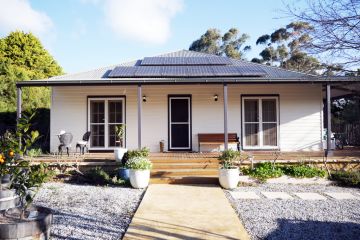Canberra's median house price experiences highest quarterly jump in six years: report
Canberra’s median house price has jumped 4.3 per cent – the highest quarterly rise in six years, according to a new report.
The median price for detached dwellings increased from $625,269 in September to $652,307 in December, the Domain December House Price Report revealed on Thursday.
It’s the second-highest quarter-on-quarter growth among Australia’s capital cities, behind Hobart on 7.9 per cent.
Sydney was the worst-performing city in this period with the median house price dropping 3.1 per cent.
Canberra’s median house price grew 9 per cent during the year, from $598,602 in December 2014.
The nation’s capital annual result trailed only Sydney and Melbourne with increases of 14.8 per cent and 14.5 per respectively.
Domain chief economist Andrew Wilson said Canberra’s quarterly jump was its highest since December 2009.
The city also recorded its strongest annual house price growth since 2009.
Gungahlin performed strongly with a 9.4 per cent rise from September to December to a median price of $630,000: a 15.6 per cent jump during the year.
But the Woden Valley recorded the highest annual increase with the region’s median house price skyrocketing 16.4 per cent to $803,000, as of December.
Dr Wilson said a better-received federal budget and interest rate cuts helped Canberra build momentum in 2015, on the back of a subdued market.
“We have to remember it’s a market that’s moved largely sideways over a three-year period. It’s really now in catch-up mode,” he said.
“I think there’s potential for further increases. We’ve seen clearance rates quite high throughout the year. We’ve seen higher volumes of auctions, signalling confidence from sellers.
“Confidence is the key and I think it’s a very confident market at the moment.”
Dr Wilson said price growth had also become more consistent.
“[Canberra is] showing some consistent growth now off the back of a number of years of really up-and-down growth.
“I think the key has been an improvement in the local economy.”
LJ Hooker Manuka proprietor Stephen Thompson said Canberra had suffered as a result of multiple changes of government.
“Up until six months ago, the three years before that we were at best plateauing and dropped a lot while the other major cities were having significant gains, so we’re coming from a low base and we’re playing catch-up,” Mr Thompson said.
“People have realised you can get a pretty high return in Canberra compared to some of the major capital cities.”
Similarly, Real Estate Institute of the ACT president Frank Pompeani said Canberra’s growth was more steady than the peaks and troughs attached to areas such as Sydney.
He said detached houses were in demand in the ACT.
“Good, solid properties that are predominantly free standing on their own block of land are highly sought after.”
While the median cost of units experienced a small increase of 0.8 per cent quarter on quarter – coming in at $405,110 – the figure represented a 2.2 per cent drop over the course of 2015.
Gungahlin was the strongest performer with the median unit price jumping 9.6 per cent over the year to $389,250.
In comparison, Weston Creek’s median price fell by 17.1 per cent over the same period to $394,950.
Woden experienced a similar price drop between September and December, with the median unit price falling by 17.4 per cent to $388,000.
Dr Wilson said the overarching result was not surprising given the number of high-density developments underway in the nation’s capital.
“Supply has certainly moved ahead of demand in those markets – that’s something we’re seeing in every capital city market,” he said.
But the lag isn’t all bad news with new projects creating extra construction jobs and feeding overall confidence.
Mr Pompeani agreed demand for apartments was still playing catch-up to supply.
“We’ve had quite a few new developments come on the market in the last five years in particular,” he said.
“Units are still a good investment but probably for the longer term.”
But units were still ideal for owner-occupiers looking for a low-maintenance property.
“Units are just in that lag mode at the moment of probably somewhere between 18 and 24 months.”
We recommend
We thought you might like
States
Capital Cities
Capital Cities - Rentals
Popular Areas
Allhomes
More







